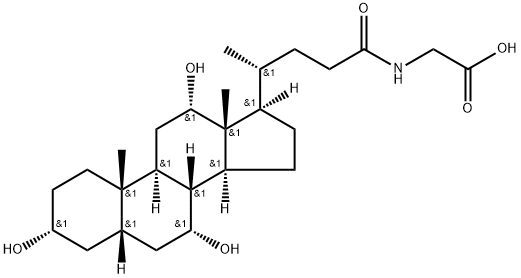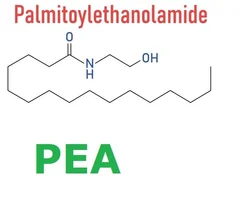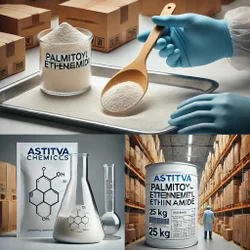Palmitoylethanolamide
Synonym(s):N-(2-Hydroxyethyl)hexadecanamide;N-(2-Hydroxyethyl)hexadecanamide, PEA, Palmidrol;Palmidrol;Palmitoylethanolamide - CAS 544-31-0 - Calbiochem;PEA
- CAS NO.:544-31-0
- Empirical Formula: C18H37NO2
- Molecular Weight: 299.49
- MDL number: MFCD00020562
- EINECS: 208-867-9
- SAFETY DATA SHEET (SDS)
- Update Date: 2025-12-26 16:58:18

What is Palmitoylethanolamide?
Description
Palmitoylethanolamide (PEA) is a fatty acid amide produced in the body that binds to and activates the peroxisome proliferator-activated receptor alpha (PPAR-α). It was initially described as an agonist to the type 2 cannabinoid receptor (CB2), though it is now recognized that PEA does not bind to cannabinoid receptors. PEA is known to have anti-inflammatory, analgesic, and neuroprotective properties. PEA supplements have been used by people with chronic pain as well as those with neuropathic pain.
Chemical properties
Palmitoylethanolamide is a natural occurring lipid belonging to the class of autacoids. It is a fine white to yellow powder. PEA consists of palmitic acid and ethanolamine. It is the hydrolyzed form of N-(2-hydroxyethyl)-palmitamide, a crystalline structure isolated in soy lecithin. It is this hydrolyzed substance that accounts for the anti-inflammatory properties that were first noted by scientists in 1957. PEA's effects on the immune system have been studied since 1939.
The Uses of Palmitoylethanolamide
Palmitoylethanolamide is a natural substance produced by the body and it is very effective and safe to use as a supplement for pain and reduce inflammation.
PEA can be synthesized within the human body from the abundant fatty acid palmitic acid, but it is not dependent or influenced by dietary consumption of fatty acids. Palmitic acid in the diet is derived from dairy products such as cheese and butter, palm tree oil, and animal meat products. However, increasing palmitic acid in the hope of increasing endogenous PEA synthesis will not be effective.
The anti-inflammatory properties of PEA are due to its ability to inhibit inflammation-causing proteins called cytokines. Cytokines are released during periods of inflammation. PEA can suppress the secretion of tumor necrosis factor alpha (TNF alpha), a cytokine, while also inhibiting the release of interleukins. Interleukins are a specific class of cytokines which belong in the immunological system and are activated during the process of inflammation.
Chronic Pain and the Use of Palmitoylethanolamide: An Update
What are the applications of Application
Palmitoylethanolamide is an endogenous cannabinoid agonist, FAAH inhibitor, and PPARα agonist.
Definition
ChEBI: Palmitoylethanolamide is an N-(long-chain-acyl)ethanolamine that is the ethanolamide of palmitic (hexadecanoic) acid. It has a role as an anti-inflammatory drug, an antihypertensive agent, a neuroprotective agent and an anticonvulsant. It is a N-(long-chain-acyl)ethanolamine, an endocannabinoid and a N-(saturated fatty acyl)ethanolamine. It is functionally related to a hexadecanoic acid.
Biological Functions
Palmitoylethanolamide (PEA) is a fatty acid amide molecule involved in a variety of cellular functions in chronic pain and inflammation. It has been shown to have neuroprotective, anti-inflammatory, anti-nociceptive (antipain) and anti-convulsant properties. Often in people with chronic disorders, the body does not produce enough PEA, which causes problems.
Taking PEA to supplement the body’s shortage is may be beneficial if you have chronic and neuropathic pain and inflammation, as has been demonstrated in clinical trials. These include peripheral neuropathies such as diabetic neuropathy, chemotherapy-induced peripheral neuropathy, carpal tunnel syndrome, sciatic pain, osteoarthritis, low-back pain, failed back surgery syndrome, dental pains, neuropathic pain in stroke and multiple sclerosis, chronic regional pain syndrome, chronic pelvic pain, postherpetic neuralgia, and vaginal pains.
Flammability and Explosibility
Not classified
Biological Activity
Palmitoylethanolamide (PEA) is a natural fatty acid amide of ethanolamine and palmitic acid. It is found in soybeans, egg yolk, and many other food sources. PEA is an endogenous cannabinoid receptor agonist. It is a peroxisome proliferator-activated receptor α (PPAR-α) ligand. PEA possesses anti-inflammatory, anti-allergic, neuroprotective, and analgesic activities. It belongs to the class of lipid mediators and the N-acylethanolamine family. PEA blocks the release of pro-inflammatory mediators from activated mast cells and prevents the recruitment of activated mast cells at the site of nerve injury.
Side Effects
There are no known problematic side-effects. PEA can be taken together with any other substance. It enhances the pain-relieving effect of classic analgesics and anti-inflammatories. Palmitoylethanolamide can be used in combination with other substances without any side effects.
ARE THERE ANY SIDE EFFECTS
Storage
Store at RT
Properties of Palmitoylethanolamide
| Melting point: | 97-98℃ |
| Boiling point: | 461.5±28.0 °C(Predicted) |
| Density | 0.910±0.06 g/cm3(Predicted) |
| vapor pressure | 0.45Pa at 20℃ |
| RTECS | ML8950000 |
| storage temp. | -20°C |
| solubility | Soluble in DMSO (up to 25 mg/ml) or in Ethanol (up to 25 mg/ml). |
| form | White solid |
| pka | 14.49±0.10(Predicted) |
| color | White |
| Water Solubility | 4.01mg/L at 20℃ |
| Stability: | Stable for 2 years from date of purchase as supplied. Solutions in DMSO or ethanol may be stored at -20° for up to 3 months. |
| CAS DataBase Reference | 544-31-0 |
| EPA Substance Registry System | Palmitoylethanolamide (544-31-0) |
Safety information for Palmitoylethanolamide
| Signal word | Danger |
| Pictogram(s) |
 Corrosion Corrosives GHS05  Environment GHS09 |
| GHS Hazard Statements |
H315:Skin corrosion/irritation H318:Serious eye damage/eye irritation H411:Hazardous to the aquatic environment, long-term hazard |
| Precautionary Statement Codes |
P264:Wash hands thoroughly after handling. P264:Wash skin thouroughly after handling. P273:Avoid release to the environment. P280:Wear protective gloves/protective clothing/eye protection/face protection. P302+P352:IF ON SKIN: wash with plenty of soap and water. P305+P351+P338:IF IN EYES: Rinse cautiously with water for several minutes. Remove contact lenses, if present and easy to do. Continuerinsing. P332+P313:IF SKIN irritation occurs: Get medical advice/attention. |
Computed Descriptors for Palmitoylethanolamide
| InChIKey | HXYVTAGFYLMHSO-UHFFFAOYSA-N |
Palmitoylethanolamide manufacturer
Gangwal Healthcare Pvt Ltd
Indexim International
New Products
4,4-Difluoropiperidine hydrochloride tert-butyl 9-methoxy-3-azaspiro[5.5]undecane-3-carboxylate Indole Methyl Resin N-Isopropylurea N,N-Dicyclohexylcarbodiimide(DCC) MELDRUMS ACID 5-METHYLISOXAZOLE-4-CARBOXYLIC ACID Magnessium Bis glycinate Zinc ascorbate 1-bromo-2-butyne 2-acetamidophenol 9(10H)-anthracenone Erythrosin B, 4-Piperidinopiperidine 2-((4-morpholinophenylamino) (methylthio) methylene) malononitrile 2,4-dihydroxybenzaldehyde 3-(4-morpholinophenylamino)-5-amino-1H-pyrazole-4-carbonitrile Methyl 2-methylquinoline-6-carboxylate 2,6-dichloro-4-nitropyridine 4-Bromo-2-chlorobenzonitrile 2-(benzylamino)acetic acid hydrochloride 4-(tert-Butoxycarbonylamino)but- 2-ynoic acid 3,4-dihydro-2H-benzo[b][1,4]dioxepine 1-Phenyl-1-cycloprppanecarboxylicacidRelated products of tetrahydrofuran



![1,2-DIHEXADECANOYL-SN-GLYCERO-3-PHOSPHO[N-HEXADECANOYL]ETHANOLAMINE AMMONIUM SALT](https://img.chemicalbook.in/CAS/GIF/108321-22-8.gif)


![1-O-[BETA-D-LACTOSYL]-N-OCTADECANOYL-DL-DIHYDROSPHINGOSINE](https://img.chemicalbook.in/CAS/GIF/15373-20-3.gif)

You may like
-
 Palmidrol 98%View Details
Palmidrol 98%View Details -
 Palmidrol 98%View Details
Palmidrol 98%View Details
544-31-0 -
 PalmitoylethanolamideView Details
PalmitoylethanolamideView Details -
 Palmitoylethanolamide CAS 544-31-0View Details
Palmitoylethanolamide CAS 544-31-0View Details
544-31-0 -
 Palmitoylethanolamide 98.00% CAS 544-31-0View Details
Palmitoylethanolamide 98.00% CAS 544-31-0View Details
544-31-0 -
 Palmitoylethanolamide 95% CAS 544-31-0View Details
Palmitoylethanolamide 95% CAS 544-31-0View Details
544-31-0 -
 Palmitoylethanolamide, PEA, CAS 544-31-0, Palmidrol, 544-31-0., Grade Standard: Nutra, Packaging Size: 5/25KGView Details
Palmitoylethanolamide, PEA, CAS 544-31-0, Palmidrol, 544-31-0., Grade Standard: Nutra, Packaging Size: 5/25KGView Details
544-31-0 -
 Palmitoylethanolamide Powder APIView Details
Palmitoylethanolamide Powder APIView Details
544-31-0
